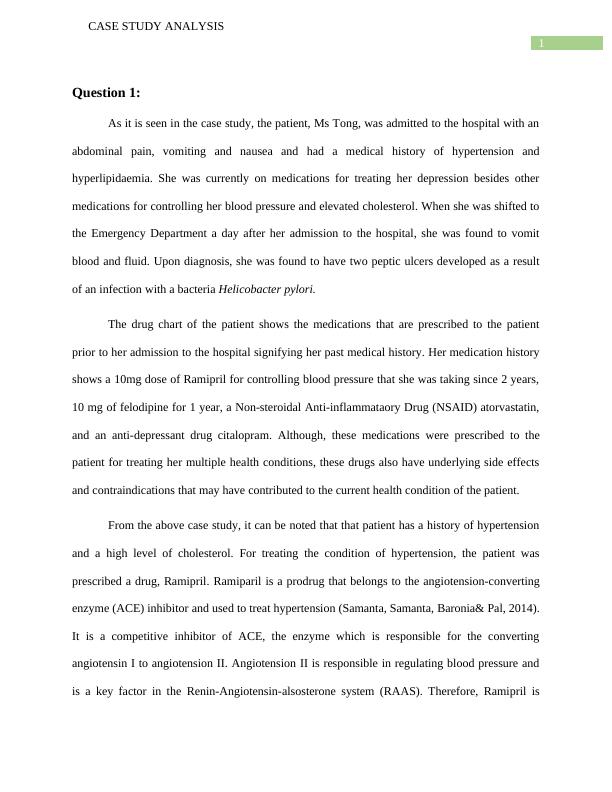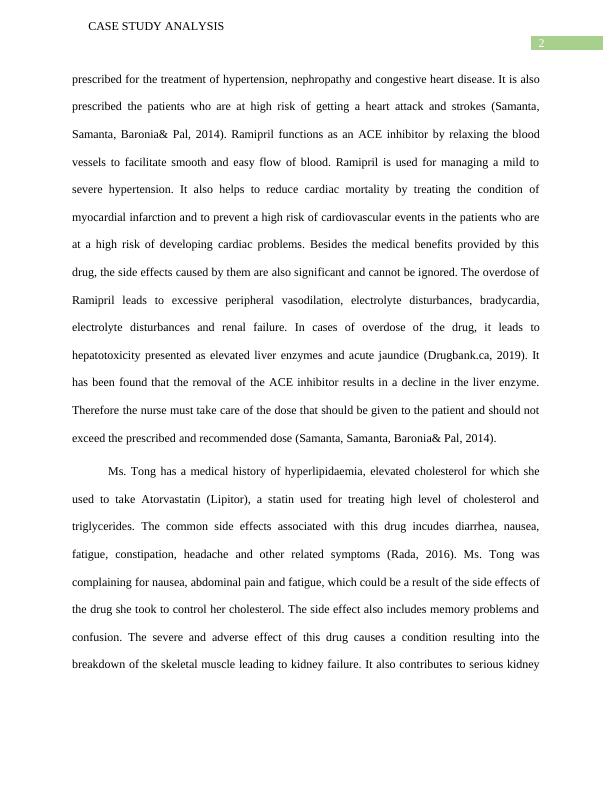Case Study Analysis NSAID 2022
Added on 2022-10-08
9 Pages2571 Words53 Views
Running head: CASE STUDY ANALYSIS
CASE STUDY ANALYSIS
Name of the Student
Name of the University
Author Note
CASE STUDY ANALYSIS
Name of the Student
Name of the University
Author Note

1
CASE STUDY ANALYSIS
Question 1:
As it is seen in the case study, the patient, Ms Tong, was admitted to the hospital with an
abdominal pain, vomiting and nausea and had a medical history of hypertension and
hyperlipidaemia. She was currently on medications for treating her depression besides other
medications for controlling her blood pressure and elevated cholesterol. When she was shifted to
the Emergency Department a day after her admission to the hospital, she was found to vomit
blood and fluid. Upon diagnosis, she was found to have two peptic ulcers developed as a result
of an infection with a bacteria Helicobacter pylori.
The drug chart of the patient shows the medications that are prescribed to the patient
prior to her admission to the hospital signifying her past medical history. Her medication history
shows a 10mg dose of Ramipril for controlling blood pressure that she was taking since 2 years,
10 mg of felodipine for 1 year, a Non-steroidal Anti-inflammataory Drug (NSAID) atorvastatin,
and an anti-depressant drug citalopram. Although, these medications were prescribed to the
patient for treating her multiple health conditions, these drugs also have underlying side effects
and contraindications that may have contributed to the current health condition of the patient.
From the above case study, it can be noted that that patient has a history of hypertension
and a high level of cholesterol. For treating the condition of hypertension, the patient was
prescribed a drug, Ramipril. Ramiparil is a prodrug that belongs to the angiotension-converting
enzyme (ACE) inhibitor and used to treat hypertension (Samanta, Samanta, Baronia& Pal, 2014).
It is a competitive inhibitor of ACE, the enzyme which is responsible for the converting
angiotensin I to angiotension II. Angiotension II is responsible in regulating blood pressure and
is a key factor in the Renin-Angiotensin-alsosterone system (RAAS). Therefore, Ramipril is
CASE STUDY ANALYSIS
Question 1:
As it is seen in the case study, the patient, Ms Tong, was admitted to the hospital with an
abdominal pain, vomiting and nausea and had a medical history of hypertension and
hyperlipidaemia. She was currently on medications for treating her depression besides other
medications for controlling her blood pressure and elevated cholesterol. When she was shifted to
the Emergency Department a day after her admission to the hospital, she was found to vomit
blood and fluid. Upon diagnosis, she was found to have two peptic ulcers developed as a result
of an infection with a bacteria Helicobacter pylori.
The drug chart of the patient shows the medications that are prescribed to the patient
prior to her admission to the hospital signifying her past medical history. Her medication history
shows a 10mg dose of Ramipril for controlling blood pressure that she was taking since 2 years,
10 mg of felodipine for 1 year, a Non-steroidal Anti-inflammataory Drug (NSAID) atorvastatin,
and an anti-depressant drug citalopram. Although, these medications were prescribed to the
patient for treating her multiple health conditions, these drugs also have underlying side effects
and contraindications that may have contributed to the current health condition of the patient.
From the above case study, it can be noted that that patient has a history of hypertension
and a high level of cholesterol. For treating the condition of hypertension, the patient was
prescribed a drug, Ramipril. Ramiparil is a prodrug that belongs to the angiotension-converting
enzyme (ACE) inhibitor and used to treat hypertension (Samanta, Samanta, Baronia& Pal, 2014).
It is a competitive inhibitor of ACE, the enzyme which is responsible for the converting
angiotensin I to angiotension II. Angiotension II is responsible in regulating blood pressure and
is a key factor in the Renin-Angiotensin-alsosterone system (RAAS). Therefore, Ramipril is

2
CASE STUDY ANALYSIS
prescribed for the treatment of hypertension, nephropathy and congestive heart disease. It is also
prescribed the patients who are at high risk of getting a heart attack and strokes (Samanta,
Samanta, Baronia& Pal, 2014). Ramipril functions as an ACE inhibitor by relaxing the blood
vessels to facilitate smooth and easy flow of blood. Ramipril is used for managing a mild to
severe hypertension. It also helps to reduce cardiac mortality by treating the condition of
myocardial infarction and to prevent a high risk of cardiovascular events in the patients who are
at a high risk of developing cardiac problems. Besides the medical benefits provided by this
drug, the side effects caused by them are also significant and cannot be ignored. The overdose of
Ramipril leads to excessive peripheral vasodilation, electrolyte disturbances, bradycardia,
electrolyte disturbances and renal failure. In cases of overdose of the drug, it leads to
hepatotoxicity presented as elevated liver enzymes and acute jaundice (Drugbank.ca, 2019). It
has been found that the removal of the ACE inhibitor results in a decline in the liver enzyme.
Therefore the nurse must take care of the dose that should be given to the patient and should not
exceed the prescribed and recommended dose (Samanta, Samanta, Baronia& Pal, 2014).
Ms. Tong has a medical history of hyperlipidaemia, elevated cholesterol for which she
used to take Atorvastatin (Lipitor), a statin used for treating high level of cholesterol and
triglycerides. The common side effects associated with this drug incudes diarrhea, nausea,
fatigue, constipation, headache and other related symptoms (Rada, 2016). Ms. Tong was
complaining for nausea, abdominal pain and fatigue, which could be a result of the side effects of
the drug she took to control her cholesterol. The side effect also includes memory problems and
confusion. The severe and adverse effect of this drug causes a condition resulting into the
breakdown of the skeletal muscle leading to kidney failure. It also contributes to serious kidney
CASE STUDY ANALYSIS
prescribed for the treatment of hypertension, nephropathy and congestive heart disease. It is also
prescribed the patients who are at high risk of getting a heart attack and strokes (Samanta,
Samanta, Baronia& Pal, 2014). Ramipril functions as an ACE inhibitor by relaxing the blood
vessels to facilitate smooth and easy flow of blood. Ramipril is used for managing a mild to
severe hypertension. It also helps to reduce cardiac mortality by treating the condition of
myocardial infarction and to prevent a high risk of cardiovascular events in the patients who are
at a high risk of developing cardiac problems. Besides the medical benefits provided by this
drug, the side effects caused by them are also significant and cannot be ignored. The overdose of
Ramipril leads to excessive peripheral vasodilation, electrolyte disturbances, bradycardia,
electrolyte disturbances and renal failure. In cases of overdose of the drug, it leads to
hepatotoxicity presented as elevated liver enzymes and acute jaundice (Drugbank.ca, 2019). It
has been found that the removal of the ACE inhibitor results in a decline in the liver enzyme.
Therefore the nurse must take care of the dose that should be given to the patient and should not
exceed the prescribed and recommended dose (Samanta, Samanta, Baronia& Pal, 2014).
Ms. Tong has a medical history of hyperlipidaemia, elevated cholesterol for which she
used to take Atorvastatin (Lipitor), a statin used for treating high level of cholesterol and
triglycerides. The common side effects associated with this drug incudes diarrhea, nausea,
fatigue, constipation, headache and other related symptoms (Rada, 2016). Ms. Tong was
complaining for nausea, abdominal pain and fatigue, which could be a result of the side effects of
the drug she took to control her cholesterol. The side effect also includes memory problems and
confusion. The severe and adverse effect of this drug causes a condition resulting into the
breakdown of the skeletal muscle leading to kidney failure. It also contributes to serious kidney

End of preview
Want to access all the pages? Upload your documents or become a member.
Related Documents
Nursing Management of Hypertensionlg...
|6
|1308
|122
Risk and Benefits of ACE Inhibitor and Calcium Channel Blocker in Hypertension Treatmentlg...
|9
|2571
|238
Medical Case Studies, Clinical Challengeslg...
|9
|2234
|124
Medication Managementlg...
|7
|1175
|214
Nursing Question Answer 2022lg...
|9
|2585
|16
Effective Risk Management Strategies for Medication-related Risks in Patients: A Case Study Analysislg...
|9
|2320
|273
